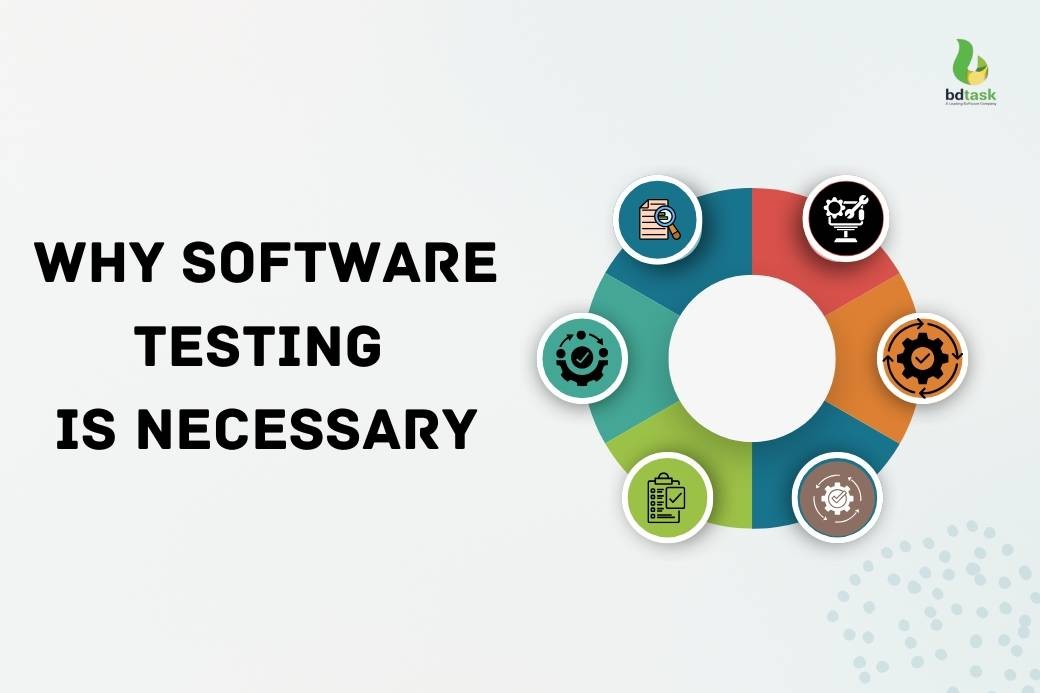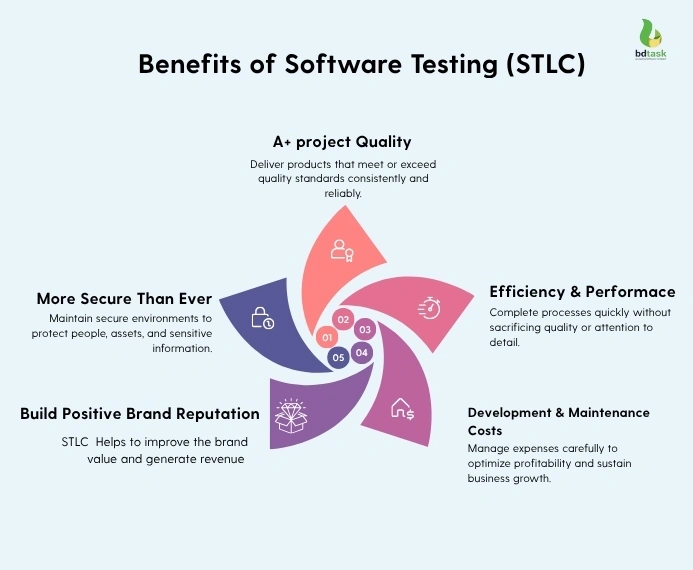Why Software Testing Is Necessary

Software is not just a word; we literally reap benefits, and it improves the lifecycle, helping businesses work more efficiently. A proper and advanced software without any bugs not only increases customer satisfaction but also improves the brand value. But few people always ask why software testing is necessary. Suppose you build a software and live it without any test procedure, then certain criteria will happen.
The first one is that after deployment, people find out bugs or defects that can lead to a serious threat to their personal information or the organization's data loss. On the other hand, the second issue brings a bad experience for the client's end. There are two simple reasons to build a bad reputation for your company as a software development company.
A software testing process helps to find out all the bugs and defects in many different processes. That's a whole other thing that happens in the SDLC life cycle.
We will discuss all of that in this blog and much more. So let's discuss it one by one and keep patients.
Let's start.
What is Software Testing - let's discuss
Software testing is a process that helps to find out any unrelated bugs or defects in the ongoing software development project. It helps to find out any missing requirements so that the final product is stable, secure, and reliable.
It's all going through a process in different phases, and it's all done by manual or advanced tools. The main goal of this process is to ensure the software functions correctly under all expected conditions.
Still, the software testing life cycle has some responsibilities: including
- Defects early in the development cycle
- Meets business and technical requirements
- Prevent future issues by improving code quality
- Deliver a smooth and error-free user experience
- Reduce long-term maintenance and support costs
Software Testing Method - Explained
Every work has some method to do. A proper method can help to reach the original goal of the desired outcome. Software testing also follows a method to complete its task. Each method has its own purpose. Let's check all of those at a glance.
Manual Testing
This testing process is all done manually. That means no software or different tools are being used in this process. The QA team are responsible for the whole process and they find out the unnecessary bugs or defects in software testing.
Automated Testing
In this process or method, all the tests are done automatically. Automatically means with tools and advanced software. With the help of these tools, the working process is faster and error-free.
Unit Testing
It's a process that targets individual components of the software that work perfectly in any circumstance or conditions.
Integration testing
Integration testing ensures that each part of the software testing process is seamlessly integrated with the others.
System Testing
It's a process to check the entire software function working as a complete system. In this process, the QA team checks the software or application to ensure it meets all the requirements that need to be completed.
Acceptance Testing
It's basically the final stage before the project goes live. In this testing phase, the team makes sure that the project can be accepted for delivery and deployment. The main concern of this testing process is that the software meets the business requirements and user needs and is fit for its intended purpose.
Performance Testing
In this method, the tester checks the performance of the project. How will it perform in different conditions, like heavy loads or heavy traffic issues?
Types Of Software Testing in SDLC
There are several types of software testing in different projects. Each project requires a different type of software testing process. But all of the types of STLC aim to produce error and bug-free software or applications. A software company like bdtask always try to maintain popular software testing types and uses its experienced software developers. Different types of software testing include:
- Functional Testing
- Non-Functional Testing
- Regression Testing
- Exploratory Testing
- Automated Testing
- Ad Hoc Testing
- Sanity Testing
- Smoke Testing
- Alpha and Beta Testing
- Grey Box Testing
All the software testing types differ from each other. It basically depends on the requirements and goals of the project. A table can define it more clearly.
|
Types Of Software Testing |
Purpose |
Example |
|
Unit Testing |
Small to large-scale software projects where code reliability is crucial |
Banking software, billing systems |
|
Integration Testing |
Different modules work together. Projects with multiple interconnected modules |
ERP systems, e-commerce platforms |
|
System Testing |
Complete integrated system, Large applications |
Hospital management system, CRM |
|
Regression Testing |
New updates don’t break existing code |
Social media apps, e-commerce sites |
|
Performance Testing |
system speed and stability, High-traffic or resource-intensive systems |
Streaming platforms, fintech apps |
|
Load Testing |
Test overall performance |
Online educational platforms |
|
Manual Testing |
Human-based testing |
small business tools |
Why Software Testing Is Necessary In SDLC
Software testing in any project is all about ensuring the quality, security, performance, and user satisfaction. Let's break down the in and out of this and why software testing is necessary in SDLC or any software development projects. Though STLC and SDLC have differences but the goal is the same, like ensuring top-notch software.

A+ Quality Of The Development Project
High-quality software is not just about meeting functional requirements; it's all about a total error-free project. STLC in SDLC helps to fill all the criteria and remove all the errors from the running project. Testing makes sure that the application works as intended, delivering consistent and predictable results.
A proper STLC support project runs smoothly in any conditions. Without software testing, software may face many issues, such as when it goes live, it faces security issues, sudden loading problems for heavy traffic & more. It also prevents reliability and reduces the random crashes or failures.
Reduces Development and Maintenance Costs
It's not like skipping this phase, which saves millions of dollars. If it was the reason, then nothing to say at all. But if not, then it's not a wise decision after all. Skipping this phase creates a thousand issues that you can not imagine. Ignoring or rushing through testing can have serious consequences for both the company and its users. An example like the 2012 Knight Capital trading bug caused a loss of over $440 million in just 45 minutes. Include:
- Poor User Experience
- Financial Losses
- Reputational Damage
- Increased Development Costs Later
These are the very few and common causes if you skip this phase. Fixing defects after deployment is far more expensive than identifying and resolving them during development. It's also led to some hidden costs. Not only increase the hidden cost, but it also increases the maintenance cost of the software. So, software testing is more necessary than ever.
More Secure Than Ever
We are all aware of the impact of cyberattacks and software hacks today. So it's essential to make sure your ready software is not vulnerable. Industries like healthcare, finance and ecommerce, where sensitive data is involved, need more secure software to perform their task. So in that area, software security is more important than ever. To maintain it properly, the company needs to maintain well-polished software that has passed the software testing process.
When a software passes this software testing process, then it's safe to use in those industries and gives a more secure experience than ever.
User Experience
User experience is the most important thing for any company. A positive user experience can build solid feedback, and that helps to find more customers at the end of the day. But now the question is how to build a positive user experience. The answer is simple. Positive user experience comes from when a customer or consumer is satisfied with using your software. Now, if the software is not secure and not user-friendly, then users will not be happy and they will give poor feedback. To maintain an A+ user experience, a software organisation or project need to pass the software testing process. A well-tested application not only satisfies users but also encourages retention and positive reviews.
Efficiency & Performance
STLC ensure that a software or application performs best under any conditions. The proper testing process in a software development project helps to find any uncertain errors or defects and helps to fix them before being ready to deploy. Without proper performance testing, apps might lag, crash, or become unresponsive, leading to negative user feedback and financial loss.
Build Positive Brand Reputation
There are a lot of software development companies in the world they known for their name and brand value. So the question is how they build it. Did they build it in one day? The answer is no. They continuously provide a quality software solution and continue software support for bug-related issues. They try to maintain a quality software solution for their valuable customer. Even customers recommended them, and that helps to enrich the brand value and reputation. Research shows that this popular company always tries to maintain a solid protocol and software testing process and SDLC patterns.
These are all the reasons why software testing is necessary in any software development project. Maintain it properly, build a positive brand value, increase customer satisfaction, and generate revenue.
End note
Above all, the discussion will learn why software testing is necessary. It's not an optional step—it’s a critical process that ensures the success of any software product. Testing is important for every part of your software development. Skipping it, on the other hand, can lead to devastating consequences—financial, technical, and reputational.
Software testing is the backbone of quality assurance. Software testing ensures that it works well, securely, and consistently in the real world.
FAQs
Can Software Development Succeed Without Testing?
No. Without testing, undetected bugs can cause software failures. Testing is important to verify that the software behaves as intended before it reaches end users.
Does Software Testing Save Time and Cost?
Yes. Early detection of bugs reduces the cost and time required for fixing issues later in the development cycle.
How Does Software Testing Ensure Software Security?
Security testing helps identify vulnerabilities like data leaks, unauthorised access, or weak authentication.
Why Is Continuous Testing Necessary in Modern Software Development?
In agile and DevOps environments, software is frequently updated. Continuous testing ensures that every new feature, update, or patch works correctly without breaking existing functionality.
What Happens If Software Testing Is Skipped?
Skipping testing can result in software crashes, data loss, system downtime, and user dissatisfaction.









